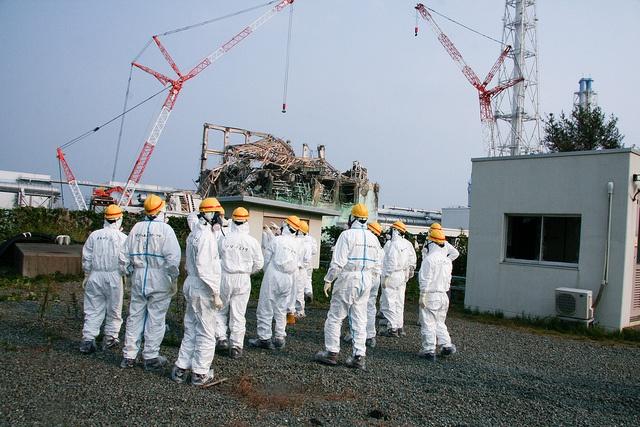
Ed. Note: Some of the information contained in this story is not verifiable. Author RP Siegel has penned an updated article, available here.
Some rather disturbing news came out this weekend about the impact of the nuclear catastrophe at Fukushima. While the incident took place five years ago and is no longer in the news, that does not mean it has been resolved. A recent report claims radioactive contamination from the accident has now spread across the entire Pacific Ocean, the massive body of water that covers nearly a third of Earth’s surface. Scientists now say the Pacific is at least five to 10 times more radioactive than it was when the U.S. began testing nuclear weapons there. Western Canada experienced levels of radioactive iodine-131 that were 300 times higher than normal background levels since the accident. Pacific herring have been found bleeding from their mouths, gills and eyes.
As the contamination made its way across the water, Oregon tuna were found in 2013 with radiation levels triple their previous levels. Starfish began dying off. The following year, California beaches recorded radiation levels that had increased by 500 percent.
As bad as that sounds, it gets worse. Remember the Deepwater Horizon oil spill? The broken pipe from the well gushed out roughly 2.4 million gallons of toxic crude into the Gulf of Mexico each day, posing a potentially lethal threat to the Gulf itself. There was a profound sense of relief around the world when the well was finally capped after 87 days.
But five years after the meltdown, radioactive waste is still pouring forth from the ruins of the Fukushima plant. Not just a little, but rather an estimated 300 tons of radioactive waste continues to spew into the ocean every day. The site, between the radioactivity and the heat, is still far too dangerous for humans or even robots to approach in an effort to try and contain the leaking cooling water that must continue to be circulated over the failed reactors, to prevent a catastrophic further meltdown.
TEPCO, the public utility that owns and is responsible for the plant, submitted a plan for decommissioning the facility, which includes dismantling the buildings, removing the fuel rods, and freezing the ground surrounding the facility to impede the flow of water. The company submits progress reports on a monthly basis to the International Atomic Energy Agency (IAEA).
There are a couple of caveats here. First, TEPCO and the Japanese government have been less than forthcoming about the entire episode -- denying, for example, that a meltdown had actually occurred until two months after the fact. Misinformation is widespread. There are a lot of websites, either spouting complete hysteria on one hand, or other sites, such as this one, that claim that the whole thing has been blown out of proportion. They don’t deny that the radiation has spread as described above, but rather they maintain that the levels being measured are not yet harmful.
If you’re comfortable with that and feel ready to go ahead and start building more nuclear plants, as apparently the U.K. is, I’d think about that carefully. The U.K. is considering the deployment of dozens of small modular reactors (SMRs) that could be in place as soon as 2030. There are several of these planned in the U.S. as well. These new designs are expected to be considerably safer than previous plants, but then again, the previous generation were supposed to be virtually foolproof. But making them smaller would be a good idea, since that would likely limit the level of damage in the case of an accident.
Plenty of analysis shows that renewables, when paired with storage and a smart grid, will provide nearly all, if not 100 percent, of our electrical energy requirements. At the same time, it has been clearly demonstrated that all forms of highly concentrated energy, be it fossil fuels or nuclear, bear considerable downside risks. In the wake of the Fukushima disaster, Japan started to reverse the trend, which was moving away from renewables until 2012. There will likely continue to be some legitimate need for new conventional sources as economies transition, but we need to be careful to maintain absolute priority for clean, safe, renewable power before approving any additional nuclear, coal, or even natural gas plants, to be sure that these are not just the most expedient, or the most profitable for those that have the ear of whoever is watching the henhouse.
Image credit: IAEA Imagebank: Flickr Creative Commons

RP Siegel (1952-2021), was an author and inventor who shined a powerful light on numerous environmental and technological topics. His work appeared in TriplePundit, GreenBiz, Justmeans, CSRWire, Sustainable Brands, Grist, Strategy+Business, Mechanical Engineering, Design News, PolicyInnovations, Social Earth, Environmental Science, 3BL Media, ThomasNet, Huffington Post, Eniday, and engineering.com among others . He was the co-author, with Roger Saillant, of Vapor Trails, an adventure novel that shows climate change from a human perspective. RP was a professional engineer - a prolific inventor with 53 patents and President of Rain Mountain LLC a an independent product development group. RP was the winner of the 2015 Abu Dhabi Sustainability Week blogging competition. RP passed away on September 30, 2021. We here at TriplePundit will always be grateful for his insight, wit and hard work.














